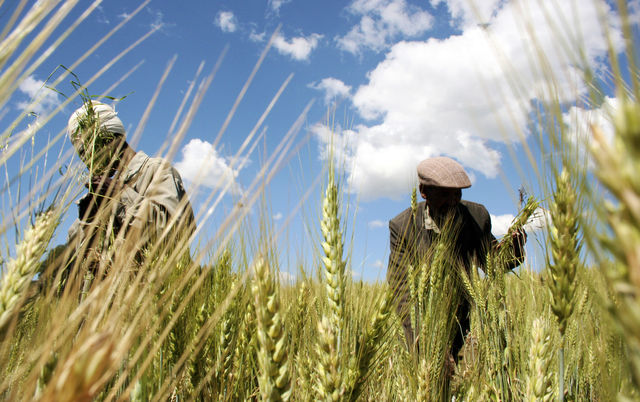New research: How countries are strengthening food security to reduce stunting
Forthcoming book chapter comes as war in Ukraine disrupts food systems and pushes price of key staples out of reach

Successful food security programs and policies have played a major role in helping several countries reduce childhood stunting – and could help guide the way for others to do the same, according to new research.
This research, based on Exemplars in Global Health findings and included in the forthcoming Elgar Handbook of Food Security and Governance to be released in late 2022, comes as health leaders are eager to identify effective levers to improve food security and reduce stunting. Researchers estimate that COVID-19 pandemic-related disruptions could result in an additional 2.6 million stunted children globally. Drought across East Africa is threatening crops and food security for more than 20 million people and the FAO is warning that Russia’s invasion of Ukraine is prompting spikes in the cost of key staples.
While no single intervention can eliminate stunting in any country, and the combination of interventions required to make progress differs everywhere, government efforts to address food security challenges served as a key lever for achieving stunting reductions in Ethiopia, the Kyrgyz Republic, Peru, and Senegal.
The research illustrates how the role of government in reducing food insecurity and improving childhood chronic undernutrition can be divided roughly into three strategies: agricultural productivity and yield, improving access to food, and reducing and managing shocks.
The first of these – improving agricultural productivity and yield – includes a range of efforts, from improving access to high quality inputs such as seeds and fertilizers, to training farmers in best practices.
Ethiopia’s Agricultural Development-Led Industrialization launched in 1994 illustrates this approach, and still guides the country’s development efforts today. As part of this initiative, the government built and staffed 15,000 farmer training centers – roughly one per village – trained and deployed 72,000 agricultural development agents to provide farmers with improved inputs on credit, and launched a hotline to provide farmers with up-to-date advice tailored to their area and crop, among other investments.
As a result, between 2004 and 2014, the number of cereal farmers in Ethiopia using fertilizer more than doubled, from 4.7 to 10.1 million. During the same period, the country's fertilized area almost doubled, from 2.7 to 5.2 million hectares. The average amount of fertilizer per hectare used also increased by 30 percent. This increase in fertilizer use is widely regarded as the driving force behind cereal yield gains. Exemplars research found that these investments and strategies helped Ethiopia reduce its childhood stunting rate from 67 percent in 1992 to 38 percent in 2016.
The Kyrgyz Republic also illustrates how governments can help drive improvements in agricultural productivity to reduce stunting. Beginning in 1994, a land reform program transformed about 500 large and highly inefficient collective farms across the country into 250,000 individual family farms by 2001.
According to the World Bank, this sequence of events “sweeping land reform and subsequent accumulation of livestock assets by peasant farms, along with their increasing commercial orientation” was responsible for rapid overall agricultural growth, rural poverty reduction, and increased food security.
The second strategy toward achieving food security, which involves improving access to food, is best illustrated in both Peru and the Kyrgyz Republic.
Peru’s conditional cash transfer program, Juntos, provided the poorest households in 1,142 of the country’s 1,800 districts with about US$63 every two months, which helped them afford more nutritious food. Peru’s leaders also improved access to food by encouraging poor families living in remote areas to move to towns with access to a wider nutritional variety, as well as health care and education. The Juntos program, launched in 2005, helped Peru reduce stunting from 37 percent in 1991 to 12 percent in 2018.
The Kyrgyz Republic’s Universal Monthly Benefit (UMB), an unconditional cash transfer benefit for the poorest families with children between the ages of 18 months and 16 years, had a similar effect. While UMB provided a modest benefit – less than US$1 per month – it was well-targeted, and provided the poorest families with a cushion against destitution. From 1997 to 2018, the stunting rate in the Kyrgyz Republic fell from 36 percent to 12 percent.
A third strategy used among these countries to improve food security and reduce stunting is implementing government policies to manage and mitigate shocks to the food system. A good example of this is Senegal’s investment in the country’s early warning food security system, its efforts to support crop diversification, and its investments in dams and an irrigation system to manage droughts and flooding. Assessment by an impact evaluation of the irrigation system program showed increased agricultural yield, food security, and reduced poverty. These investments and the increased number of agricultural extension agents previously mentioned, among other investments, helped Senegal reduce childhood stunting from 34 percent in 1992 to 17 percent in 2017.
Likewise, Ethiopia’s Participatory Small-Scale Irrigation Development Program implemented in four states between 2008 and 2015, targeted drought-prone and food-insecure districts, and helped farmers own and manage their own irrigation systems through community-based water use associations. The leaders of these associations were trained in effective water management and distribution.
The research also makes clear that what matters is not just what investments a country makes, but also how it makes those investments. Political will, financial commitment (the setting of clear, specific targets), collecting good data to develop and scale data-driven interventions, and targeting the most vulnerable are each powerful predictors and influencers of a country’s success in reducing stunting.
